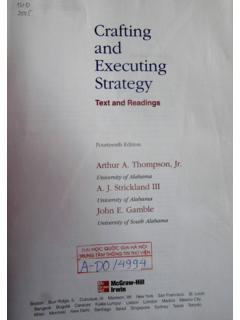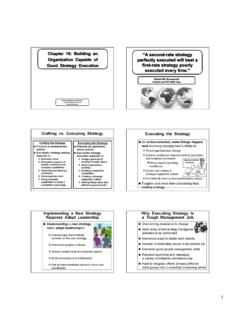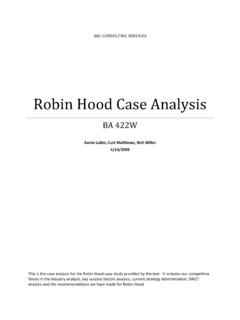Transcription of Evaluating a Company’s External Environment
1 Thompson Strickland Gamble: crafting and executing strategy : Concepts and Cases, 17th EditionI. Concepts and Techniques for crafting and executing Strategy3. Evaluating a company s External Environment The McGraw Hill Companies, 2010 CHAPTER3 Evaluating a company s External Environment LEARNING OBJECTIVES gain command of the basic concepts and analytical tools widely used to diag-nose a company s industry and competitive conditions. become adept at recognizing the factors that cause competition in an industry to be fierce, more or less normal, or relatively weak. learn how to determine whether an industry s outlook presents a company with sufficiently attractive opportunities for growth and profitability.
2 Understand why in-depth evaluation of specific industry and competitive condi-tions is a prerequisite to crafting a strategy well matched to a company s situation. Thompson Strickland Gamble: crafting and executing strategy : Concepts and Cases, 17th EditionI. Concepts and Techniques for crafting and executing Strategy3. Evaluating a company s External Environment The McGraw Hill Companies, 2010 Analysis is the critical starting point of strategic thinking. Kenichi Ohmae Consultant and Author Things are always different the art is figuring out which differ-ences matter. Laszlo Birinyi Investments Manager Competitive battles should be seen not as one-shot skirmishes but as a dynamic multiround game of moves and countermoves.
3 Anil K. Gupta Professor In the opening paragraph of Chapter 1, we said that one of the three central questions that man-agers must address in Evaluating their company s business prospects is What s the company s present situation? Two facets of a company s situation are especially pertinent: (1) the industry and competi-tive Environment in which the company operates and (2) the company s collection of resources and capa-bilities, its strengths and weaknesses vis- -vis rivals, and its windows of opportunity. Insightful analysis of a company s External and internal Environment is a prerequisite for crafting a strategy that is an excellent fit with the company s situation, is capable of building competitive advan-tage, and holds good prospect for boosting company performance the three criteria of a winning strategy .
4 As depicted in Figure , the task of crafting a com-pany s strategy should always begin with appraisals of the company s External Environment and internal Environment (as a basis for deciding on a long-term strategic direction and developing a strategic vision), then proceed to an evaluation of the most promising alternative strategic options and business models, and culminate in choosing a specific strategy . This chapter presents the concepts and analyti-cal tools for zeroing in on a single-business com-pany s External Environment . Attention centers on the competitive arena in which a company operates, the drivers of market change, and rival companies actions.
5 In Chapter 4 we explore the methods of Evaluating a company s internal circumstances and competitiveness. Thompson Strickland Gamble: crafting and executing strategy : Concepts and Cases, 17th EditionI. Concepts and Techniques for crafting and executing Strategy3. Evaluating a company s External Environment The McGraw Hill Companies, 201056 Part 1 Concepts and Techniques for crafting and executing strategy THE STRATEGICALLY RELEVANT COMPONENTS OF A company S External Environment All companies operate in a macroenvironment shaped by influences emanating from general economic conditions; population demographics; societal values and lifestyles; legislation and regulations; technology; and, closer to home, the industry and competi-tive Environment in which the company operates (see Figure ).
6 Strictly speaking, a company s macroenvironment includes all relevant factors and influences outside the company s boundaries; by relevant, we mean important enough to have a bearing on the decisions the company ultimately makes about its direction, objectives, strategy , and business model. Strategically relevant influences coming from the outer ring of the macroenvironment can sometimes have a high impact on a company s business situation and have a very significant impact on the company s direction and strategy . The strategic opportunities of cigarette producers to grow their business are greatly reduced by antismoking ordinances and the growing cultural stigma attached to smok-ing.
7 Motor vehicle companies must adapt their strategies (especially as concerns the fuel mileage of their vehicles) to customer concerns about gasoline prices. The demo-graphics of an aging population and longer life expectancies are having a dramatic impact on the business prospects and strategies of health care and prescription drug companies. Companies in most all industries have to craft strategies that are respon-sive to environmental regulations, growing use of the Internet, and energy prices. Companies in the food processing, restaurant, sports, and fitness industries have to pay special attention to changes in lifestyles, eating habits, leisure-time preferences, and attitudes toward nutrition and fitness in fashioning their strategies.
8 Thinkingstrategicallyabout acompany sexternalenvironmentIdentifypromisingstr ategicoptionsfor thecompanySelect thebeststrategyandbusinessmodelfor thecompanyThinkingstrategicallyabout acompany sinternalenvironmentForm astrategicvision of where thecompanyneeds tohead Figure From Thinking Strategically about the company s Situation to Choosing a strategy Thompson Strickland Gamble: crafting and executing strategy : Concepts and Cases, 17th EditionI. Concepts and Techniques for crafting and executing Strategy3. Evaluating a company s External Environment The McGraw Hill Companies, 2010 Chapter 3 Evaluating a company s External Environment 57 Happenings in the outer ring of the macroenvironment may occur rapidly or slowly, with or without advance warning.
9 The impact of outer-ring factors on a compa-ny s choice of strategy can range from big to small. But even if the factors in the mac-roenvironment change slowly or affect a company s situation only modestly, there are enough strategically relevant outer-ring trends and events to justify a watchful eye. As company managers scan the External Environment , they must be alert for potentially important outer-ring developments, assess their impact and influence, and adapt the company s direction and strategy as needed. However, the factors and forces in a company s macroenvironment having the big-geststrategy-shaping impact typically pertain to the company s immediate industry and competitive Environment the actions of rivals firms, buyer behavior, supplier-related considerations, and so on.
10 Consequently, it is on a company s industry and competitive Environment that we concentrate our attention in this chapter. SocietalvaluesandlifestylesPopulationdem ographicsLegislationandregulationsTechno logyGeneraleconomicconditionsMacroenviro nmentCOMPANYS ubstituteproductsSuppliersRivalfirmsNewe ntrantsBuyersImmediateindustryandcompeti tiveenvironmentFigure The Components of a company s Macroenvironment Thompson Strickland Gamble: crafting and executing strategy : Concepts and Cases, 17th EditionI. Concepts and Techniques for crafting and executing Strategy3. Evaluating a company s External Environment The McGraw Hill Companies, 201058 Part 1 Concepts and Techniques for crafting and executing StrategyTHINKING STRATEGICALLY ABOUT A company S INDUSTRY AND COMPETITIVE Environment To gain a deep understanding of a company s industry and competitive Environment , managers do not need to gather all the information they can find and spend lots of time digesting it.












